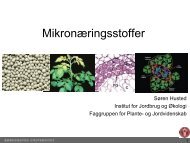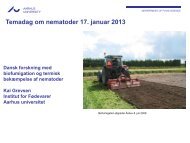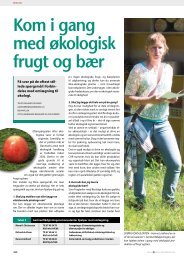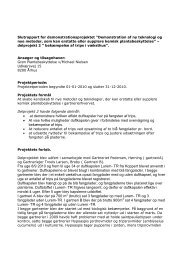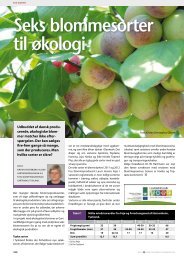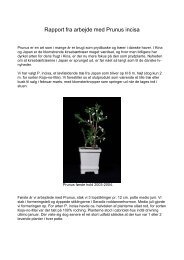DLV Plant
DLV Plant
DLV Plant
You also want an ePaper? Increase the reach of your titles
YUMPU automatically turns print PDFs into web optimized ePapers that Google loves.
Velkommen DanmarkNematodes eat your wallet emptyPart 1: Nematode controlinstruction byBert Aasman, manager <strong>DLV</strong> plant2013 januar 17Bert Aasman; +31653152389© <strong>DLV</strong> <strong>Plant</strong>
<strong>DLV</strong> <strong>Plant</strong> Advice and Reseach partner© <strong>DLV</strong> <strong>Plant</strong>
<strong>DLV</strong> <strong>Plant</strong> – Pillars• Agricultural consultancy in The Netherlands with 185 advisors• We have contacts in 141 countries• Worldwide more than 11000 satisfied customers• More than 100 years of experience• Our services are based on four main activities:– Advice– Practical Research– Projects– International services© <strong>DLV</strong> <strong>Plant</strong>
Every farm have nemtodes© <strong>DLV</strong> <strong>Plant</strong>
Program topicsNematodes control in steps:– Meloidogyne hapla– Meloidogyne naasi– Pratylenchus penetrans– Trichodoriden© <strong>DLV</strong> <strong>Plant</strong>
What are Nematodes?• Roundworms 0,2 mm to 10 mm• Not observable with the naked eye• Nematodes cause damage to the root,and sometimes other parts of the plant© <strong>DLV</strong> <strong>Plant</strong>
Situation in the NetherlandsCropCarrot (small,washed andbroken)10-15% loss of yield and qualitycaused by nematodesHectares2009 2010 20113250 2950 3200Carrot (large) 5560 5568 5800© <strong>DLV</strong> <strong>Plant</strong>
Step 1: Diagnosis in the field• Identification in the field© <strong>DLV</strong> <strong>Plant</strong>
Step 2: Diagnosis on roots• Identifation on the crop© <strong>DLV</strong> <strong>Plant</strong>
Step 3: Mark the place in the field• Capture with GPS or Map© <strong>DLV</strong> <strong>Plant</strong>
Step 4: Soil research• Soil research© <strong>DLV</strong> <strong>Plant</strong>
Step 5: Measures to control nematodes• Crop rotation:– Crop sequence and nematode diagram• Cultivation measures:– Sowing time– Wet and cold– Drainage• Green manure:– Resistance and susceptibility (Non-host plant)© <strong>DLV</strong> <strong>Plant</strong>
10-jan-13Heterodera carotaePeencysteaaltjeMeloidogyne haplaNoordelijk wortelknobbelaaltjeMeloidogyne naasiGraswortelknobbelaaltjeMeloidogyne chitwoodiMaïswortelknobbelaaltjePratylenchus penetransWortellesieaaltjePratylenchus crenatusGraanwortellesieaaltjeParatylenchus bukowinensisSpeldaaltjeTrichodorus primitivusTrichodorus primitivusTrichodorus similisTrichodorus similisParatrichodorus pachydermusParatrichodorus pachydermusParatrichodorus teresParatrichodorus teresCrop rotation Nematode diagramNematode diagram 2013Versie: 03.048CysteaaltjesWortelknobbelaaltjes Wortellesieaaltjes Vrijlevende wortelaaltjesvasket i dansk Z D ZA K Z D Z D ZA Z D Z D ZA Z D ZA Z D ZA K Z D ZA Z D ZA Z D ZA Z D ZAGulerod ••• •• - •• •• • ••• •• • •• •• Peenjordbær - ••• - - ••• ? ? ? ? ? ? Aardbeipopulation grow legend? unknownDamage legendAA active declaneunknown- natural declinenone• small increase5-15% small•• moderate increase16-33% moderate••• strong increasR rasafhankelijk>33% strongSource: PPO www.aaltjesschema.nlSoil type legendDpeatKclayZsandZA sandy clay© <strong>DLV</strong> <strong>Plant</strong>
Case crop rotationFarm 1problem755 l+e/100 mlMeloidogyne haplacroprotationHost plant for M. haplarotation increase color of damagecarrot••potato •••wheat - = > 33% damageoats - = 15 - 33% damagebarley - = 5-15% damagebeans ••• = no damagepeas •• = unknowncorn -clover •••Source: PPO www.aaltjesschema.nl© <strong>DLV</strong> <strong>Plant</strong>
e+l/100 ml soilCase crop rotation• Damage carrots 100 e+l/100 mlPopulation development M. Hapla farm 140003500300025002000popultion start150010005000potatowheatoatsbarleybeanspeascornclovercarrotspotatoCroprotationSource: PPO www.aaltjesschema.nl© <strong>DLV</strong> <strong>Plant</strong>
Case crop rotation : solution Meloidogyne haplaNew rotation and a bettre situation for carrotsrotationpotatowheat -oats -•••••carrotsbarley -••••••••peasbeansclovercorn -potato•••Source: PPO www.aaltjesschema.nl© <strong>DLV</strong> <strong>Plant</strong>
e+l/100 ml soilCase crop rotation : solution• Damage carrots 100 e+l/100 mlPopulation develoipment M hapla new40003500300025002000population start150010005000potatowheatoatscarrotsbarleypeasbeansclovercornpotatoCroprotation newSource: PPO www.aaltjesschema.nl© <strong>DLV</strong> <strong>Plant</strong>
Cultivation measures Life cycle Meloidogyne• Active above 5 °C• Penetrate the roots• 2-3 Generations perseason• They don’t need anattractant• They will starve soonwhen there are no rootsof susceptible crops© <strong>DLV</strong> <strong>Plant</strong>
Cultivation measures Meloidogyne hapla• Crop prior to a sensitive crop:Grasses, cereals, corn and lilies don’t increase the amount ofM. hapla• No weeds in and after the crop• No legumes in crop rotation• Sowing the sensitive crop later, after a period of black fallow.When? Depends on temperature and the reduce of nematodes.• Minimal contamination for damages: 100 living larvae/100 ml© <strong>DLV</strong> <strong>Plant</strong>
Meloidogyne chitwoodi: lettuce and carrot© <strong>DLV</strong> <strong>Plant</strong>
Meloidogyne chitwoodi: crop rotation• Grow the most sensitive crop immediately afterthe crop with the least propagation;• Late sowing (to early June) indicates a strongdieback of the corn root knot nematode, sodamage can be limited;• Black fallow is a very effective remediationmethod;• Damage from 10 living larvae/100 ml.© <strong>DLV</strong> <strong>Plant</strong>
Pratylenchus penetrans: life cycle• Mobile in all stages• 2-3 generations• Short life• Light soil• Damage from 100 living larvae/100 ml.© <strong>DLV</strong> <strong>Plant</strong>
Pratylenchus penetrans: carrotFoto PPO AGV© <strong>DLV</strong> <strong>Plant</strong>
Pratylenchus penetrans: strawberry© <strong>DLV</strong> <strong>Plant</strong>
10-jan-13Pratylenchus penetransWortellesieaaltjePratylenchus crenatusGraanwortellesieaaltjePratylenchus penetransNematode diagram 2013Versie: 03.048Wortellesieaaltjesvasket i dansk Z D ZA Z D ZAGulerod •• • PeenAardbei ••• ? AardbeiBoerenkool • ? BoerenkoolBroccoli ••• ? BroccoliChinese kool • ? Chinese koolCourgette ? ? CourgetteMaggi ••• ? MaggiPeterselie krul/plat ••• ? Peterselie © <strong>DLV</strong> <strong>Plant</strong> krul/plat
Pratylenchus penetrans: Tagetus patula• between May 10 and July 20• 3-4 kg seeds• N: 150 kg/ha• The cultivation of Tagetes patula is the most effective controlmeasure for the root lesion nematodes Pratylenchus penetrans.• Tagetus patula has to grow at least 3 month. Therefore sow aslate as June.© <strong>DLV</strong> <strong>Plant</strong>
Pratylenchus penetrans: control• Grow, prior to a sensitive crop, a poor host plant such assugar beet, spinach or beetroot;• The cultivation of Tagetes patula is the most effectivecontrol measure for the root lesion nematodesPratylenchus penetrans, but note the presence ofparticular Trichodoriden. Tagetes greatly increases thesespecies;• After the main crop, use green manure only as a means toreduce wind erosion and spray it dead after 5 weeks; Letyour green manure in no case beyond the wintertime;© <strong>DLV</strong> <strong>Plant</strong>
Paratylenchus bukowinensis•Pin nematodes•Cause damage to umbelliferous plants if these cropsare grown in rotation too close•Choose unions and spring wheat as preceding crop.•Tollerance: 30/100 cm 3•Natural decline:•1: 0%•2: 60%•3: 60%•4: 60%© <strong>DLV</strong> <strong>Plant</strong>
10-jan-13Paratylenchus bukowinensisSpeldaaltjeNematode diagram 2013Paratylenchus bukowinensisVersie: 03.048vasket i danskZ D ZA KGulerod •••Aardbei ?BoerenkoolBroccoli ?Chinese koolCourgette ?Maggi ?Peterselie krul/plat ?Prei ?Rabarber ?Rode biet ?Selderij- blad ?Selderij- bleek ?Selderij, knol•••••••••Sla ?Sluitkool •••Spruitkool •••© <strong>DLV</strong> <strong>Plant</strong>
Trichodorus species: life cycle• Very mobile• 2-3 generations• Short life• Light soils• Moist soil• Ectoparasite• Trichodorus primitivus• Trichodorus similis• Paratrichodoruspachydermis• Paratrichodorus teres© <strong>DLV</strong> <strong>Plant</strong>
Trichodorus: carrot© <strong>DLV</strong> <strong>Plant</strong>
10-jan-13Trichodorus primitivusTrichodorus primitivusTrichodorus similisTrichodorus similisParatrichodorus pachydermusParatrichodorus pachydermusParatrichodorus teresParatrichodorus teresTrichodorus specieshost plantsNematode diagram 2013Versie: 03.048Vrijlevende wortelaaltjesvasket i dansk Z D ZA Z D ZA Z D ZA Z D ZAGulerod •• • •• •• PeenAardbei ? ? ? ? AardbeiBoerenkool ? ? ? ••• BoerenkoolBroccoli ? ? ? ••• BroccoliChinese kool ? ? ? ••• Chinese kool© <strong>DLV</strong> <strong>Plant</strong>
Trichodorus species: control• Trichodoride nematodes cause particular problems with theemergence of many crops. The risk of damage is greater in acold and wet spring;• Grow damage sensitive crops after a crop that badly increasesthe nematodes. Different types of Trichodoride nematodes areoften mixed.• Fodder radish has the added advantage that the tobacco rattlevirus is reduced.• Draining© <strong>DLV</strong> <strong>Plant</strong>
Trichodorus species: control• In connection with other nematodes, let your greenmanure in no case beyond the wintertime;• Damage from ca 100 living larvae/100 ml ?• Paratrichodorus teres:There are also good experiences with extra organicmatter in the topsoil. This organic matter disturbesthe environment of the nematode.© <strong>DLV</strong> <strong>Plant</strong>
Summary• Find nematodes:– In the field– In the crop• Nematode soil testing:– You have to know which nematodes species and how many• Crop rotation:– Crop sequence• Cultivation measures– Sowing time– Wet and cold– Draining© <strong>DLV</strong> <strong>Plant</strong>
SummaryImportant websites:‣ www.aaltjesschema.nl‣ www.kennisakker.nl‣ www.dlvplant.nl<strong>DLV</strong> <strong>Plant</strong> for independed advisory© <strong>DLV</strong> <strong>Plant</strong>
Velkommen DanmarkNematodes eat your wallet emptyPart 2: Green manure:Resistance and susceptibility (Non-host plant)instruction byBert Aasman, manager <strong>DLV</strong> plant2013 januar 17Bert Aasman; +31653152389© <strong>DLV</strong> <strong>Plant</strong>
11-jan-13Meloidogyne haplaNoordelijk wortelknobbelaaltjeMeloidogyne naasiGraswortelknobbelaaltjeMeloidogyne chitwoodiMaïswortelknobbelaaltjePratylenchus penetransWortellesieaaltjeDitylenchus dipsaciStengelaaltjeParatylenchus bukowinensisSpeldaaltjeTrichodorus primitivusTrichodorus primitivusTrichodorus similisTrichodorus similisParatrichodorus pachydermusParatrichodorus pachydermusParatrichodorus teresParatrichodorus teresGreen manure host or no hostNematode diagram 2013Versie: 03.048 Wortelknobbelaaltjes Wortellesieaaltjes StengelaaltjesVrijlevende wortelaaltjesSource PPO www.aaltjesschema.nlZ D Z D ZA Z D Z D ZA Z D ZA K Z D ZA K Z D ZA Z D ZA Z D ZA Z D ZAAlexandrijnse klaver op braak land ••• ? ••• ••• ? ? ? ? ? • AlexandrBladrammenas op braak land •• - - R ••• ? ? ••• •• •• • BladrammEngels raaigras op braak land - ••• • •• • ? ••• ••• ••• ••• Engels raFacelia op braak land •• - • ••• ? ? • ? •• ? Facelia oGierst parel- op braak land ? ? ? ? ? ? ? ? ? ? Gierst paItaliaans raaigras op braak land - ••• ••• ••• • ? ••• ••• ••• ••• ItaliaansJapanse haver ? ? ••• - ? ? ? ? ? ? JapanseKlaver op braak land ••• R - ••• R ••• - ? ••• ••• ••• ••• Klaver opLupine op braak land ••• ? ? ••• ? ? ? ? ? ••• Lupine opPerzische klaver op braak land ••• ? ••• ••• ? ? ? ? ? • R Perzische© <strong>DLV</strong> <strong>Plant</strong>
Meloidogyne hapla: green manure• Provide an excellent weed control!• If M. hapla is the only problem then grass or rye;• Black fallow is a very effective remediation method.© <strong>DLV</strong> <strong>Plant</strong>
Pf/PiPratylenchus penetrans: green manurePopulation increase Pratylenchus penetrans1098765Reeks143210Fallow strigosa RaphanobrassicaSativaNematRaphanosativawinterboon winterwikkegreen manure© <strong>DLV</strong> <strong>Plant</strong>
numbers nemaohdePratylenchus penetrans: green manureVermeerdering P. penetrans Pi 35010009008007006005004003002001000Reeks1braakT. patulaInglis rajgræsvoldtægtzaadmeelbroccolisareptasværd agersennepgul sennepolieræddikecrambesoedaan græskålbladgreen manure© <strong>DLV</strong> <strong>Plant</strong>
Meloidogyne chitwoodi: green manure• Provide an excellent weed control!• Use green manure as a way to reduce wind erosionand spray it dead after 5 weeks;• Let your green manure in no case beyond thewintertime;• Fodder radish that is resistant to M. chitwoodi maybe the winter remain;• Please note other types of harmful nematodes, forwhich fodder radish is not resistant;• Black fallow is a very effective remediation method.© <strong>DLV</strong> <strong>Plant</strong>
Trichodorus spp: green manure• Let your green manure in no case beyond thewintertime, in connection with other nematodes• All the green manure increase Trichodorus thebest is olieræddike, but it is difficult© <strong>DLV</strong> <strong>Plant</strong>
Thanks for your attention!Nematodes eat your wallet empty:Rootcrops don't like itinstruction byBert Aasman, manager <strong>DLV</strong> plant2012 February 9Bert Aasman; +31653152389© <strong>DLV</strong> <strong>Plant</strong>



